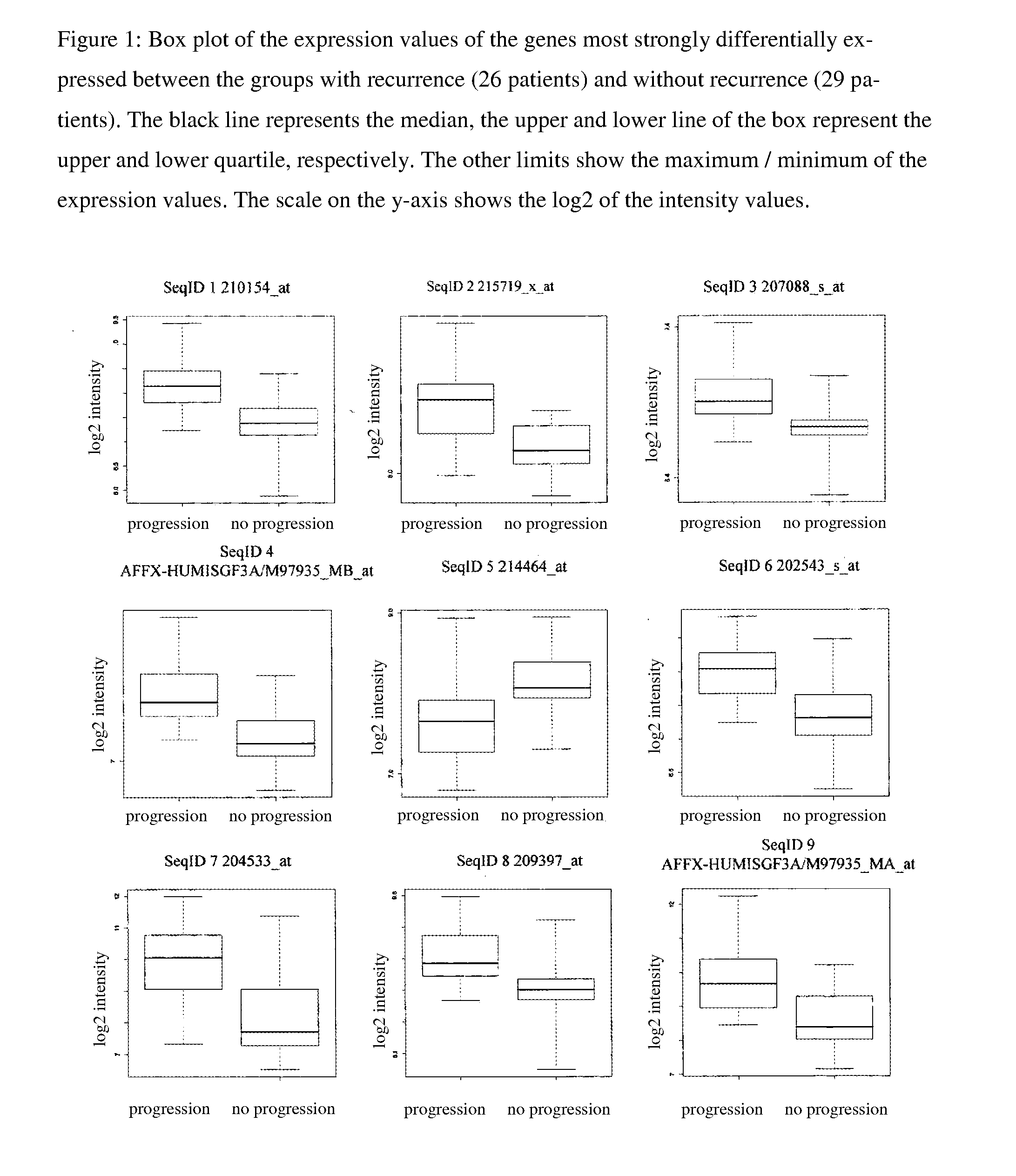Prognostic markers for classifying colorectal carcinoma on the basis of expression profiles of biological samples
a technology of colorectal cancer and prognostic markers, which is applied in the field of prognostic markers for classifying colorectal cancer on the basis of biological sample expression profiles, can solve the problems of difficult to predict the benefit of such a therapy, the inability to resection, and the inability to identify patients with a high probability of progression
- Summary
- Abstract
- Description
- Claims
- Application Information
AI Technical Summary
Problems solved by technology
Method used
Image
Examples
example 2
Microrray Experiments
[0057]To the cRNA, B2-control oligonucleotide (Affymetrix, Santa Clara, Calif.), eukaryotic hybridization controls (Affymetrix, Santa Clara, Calif.), herring's sperm (Promega, Madison, Wis.), hybridization buffer and BSA were added to a final volume of 300 μl. The cRNA was hybridized on a Microarraychip U1233A (Affymetrix, Santa Clara, Calif.) for 16 hours at 45° C. The wash- and incubation steps with streptavidin (Roche, Mannheim), biotinylated goat-anti-streptavidin antibody (Serva, Heidelberg), goat-IgG (Sigma, Taufkirchen) and streptavidin-phycoerythrin conjugate (Molecular Probes, Leiden, The Netherlands) were performed on an Affymetrix Fluidics Station according to the manufacturer's protocol.
[0058]Subsequently, the arrays were scanned with a confocal microscope based on a HP-Argon-Ion laser and the digitalized picture data was processed using the Affymetrix® Microarry Suite 5.0 Software. The gene chips underwent a quality control to remove scans with abno...
example 3
Bioinformatical Analysis
[0059]The statistical data analysis was performed with the Open-Source Software R, Version 2.3 and the Bioconductor Packages, Version 1.8. Based on the 55 CEL-Files, which are created by the above-referenced Affymetrix Software, the gene expression values were determined through FARMS condensation [Hochreiter et al. (2006), Bioinformatics 22(8):943-9].
[0060]Based on the clinical data of 55 patients, the classification problem “classification of 55 expression data sets after progression-free survival of the respective patients” was formulated and analyzed. The expression data set stemmed from the above-described patients, of which in 26 a progression occurred, while for 29 of the patients progression-free survival was documented. The marker genes according to the invention were, as shown in FIG. 3, determined with a double-nested boot strap approach [Efron (1979) Bootstrap Methods—Another Look at the Jackknifing, Ann. Statist. 7, 1-6]. In the outer loop, the s...
PUM
| Property | Measurement | Unit |
|---|---|---|
| Fraction | aaaaa | aaaaa |
| Digital information | aaaaa | aaaaa |
| Gene expression profile | aaaaa | aaaaa |
Abstract
Description
Claims
Application Information
 Login to View More
Login to View More - R&D
- Intellectual Property
- Life Sciences
- Materials
- Tech Scout
- Unparalleled Data Quality
- Higher Quality Content
- 60% Fewer Hallucinations
Browse by: Latest US Patents, China's latest patents, Technical Efficacy Thesaurus, Application Domain, Technology Topic, Popular Technical Reports.
© 2025 PatSnap. All rights reserved.Legal|Privacy policy|Modern Slavery Act Transparency Statement|Sitemap|About US| Contact US: help@patsnap.com



